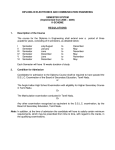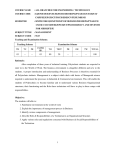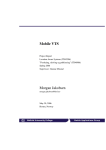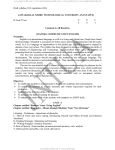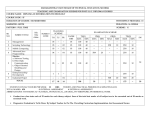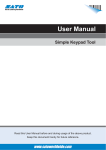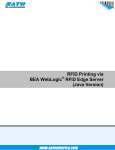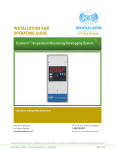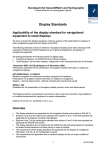Download IA_Sem_1st
Transcript
MAHARASHTRA STATE BOARD OF TECHNICAL EDUCATION , MUMBAI TEACHING AND EXAMINATION SCHEME COURSE NAME : ADVANCE DIPLOMA IN INFORMATION TECHNOLOGY COURSE CODE : IA DURATION OF COURSE : TWO SEMESTERS/ONE YEAR DURATION: 16 WEEKS SEMESTER : FIRST WITH EFFECT FROM 2007-08 FULL TIME / PART TIME: FULL TIME SCHEME - C SR. NO SUBJECT TITLE SUBJECT CODE TEACHING SCHEME EXAMINATION SCHEME TH TU PR PAPER HRS TH Max Min TEST TOTAL Max Min PR Max Min OR Max Min TW Max Min 1 Computing Essential 9734 03 -- 04 03 80 36 20 100 50 50@ 25 -- -- -- -- 2 Programming in C 9735 02 02 04 03 80 36 20 100 50 50# 25 -- -- 50@ 25 3 Database Programming 9736 03 -- 04 03 80 36 20 100 50 50# 25 -- --- 50@ 25 4 Visual Basic -- 02 -- 04 -- -- -- -- -- -- 50# 25 -- -- 50@ 25 5 Professional Practice -- -- -- 04 -- -- -- -- -- -- -- -- -- -- 50@ 25 6 Mini Project -- -- -- 02 -- -- -- -- -- -- -- -- -- -- 50@ 25 10 02 22 -- 240 -- 60 300 -- 200 -- -- -- 250 -- TOTAL STUDENT CONTACT HOURS PER WEEK(FORMAL TEACHING) : 34 HRS THEORY AND PRACTICAL PERIODS ARE OF 60 MINUTES EACH @ - INTERNAL ASSESSMENT , # - EXTERNAL ASSESSMENT TOTAL MARKS – 750 ABBREVIATIONS : TH – THEORY , TU – TUTORIAL , PR – PRACTICALS , OR –ORAL, TW – TERMWORK All assessment of practical, oral and term work are to be done as per the prevailing norms of implementation and assessment 1 COURSE NAME : ADVANCE DIPLOMA IN INFORMATION TECH NOLOGY COURSE CODE : IA SEMESTE : FIRST SUBJECT NAME : COMPUTING ESSENTIALS SUBJECT CODE : 9734 TEACHING AND EXAMINATION SCEME: Examination Scheme Teaching Scheme TH TU PR PAPER HRS TH TEST PR OR TW TOTAL 03 - 04 03 80 20 50@ -- -- 150 RATIONALE: Computer plays an important role in human lives. The primary purpose of using a computer is to make life easier. It is a gateway to a wonderful world of information and various applications. Computers have established an indispensable part in a business, academics, defense, budgeting, research, engineering, medicine, space. This subject introduces the fundamentals of computer system focusing various hardware and software components. It also provides biblical worldview regarding computer ethics by means of Internet. OBJECTIVES:-The students will be able to : 1. 2. 3. 4. 5. 6. 7. 8. Understand a computer system that has hardware and software components, which controls and makes them useful. Understand the operating system as the interface to the computer system. Use the basic functions of an operating system. Set the parameter required for effective use of hardware combined with and application software’s Compare major OS like Linux and MS-Windows Use file mangers, word processors, spreadsheets, presentation software’s and Internet. Have hands on experience on operating system and different application software Use the Internet to send mail and surf the World Wide Web. 2 3 CONTENTS: Theory Note: Contents of theory are to be taught in Practical Period Chapter Name of the Topic Fundamentals Of Computer Introduction Block Diagram Of Computer Components of PC The system Unit 1 Front part of system Unit Back part of system Unit CPU, Memory of computer,Monitor Mouse, Keyboard Disk, Printer, Scanner, Modem, Video, Sound cards, Speakers, Applications of Computers Operating Systems 1.Disk Operating System Internal and External commands 2 2. Windows Operating system Working with window Desktop Components of window Menu bar option Starting window Getting familiar with desktop Moving from one window to another Reverting windows to its previous size Opening task bar buttons into a windows Creating shortcut of program Quitting windows GUI Based Editing ,Speadsheets,Tables & Presentation a)MS-Word Marks Hours 10 06 08 05 08 05 10 06 12 06 06 06 Menus 3 4 Opening, menus, Toolbars, standard toolbars, formatting toolbars & closing Quitting Document ,Editing & designing your document, inserting table,inserting pictures,mail merging,page setup,printing of documents. b) MS-Excel Spreadsheets, Working & Manipulating data with Excel changing the layout,inserting functions and formulaes Working with simple graphs, c) MS-Powerpoint 4 5 6 7 Presentation, Working With PowerPoint and Presentation d)MS-Access Creating tables, inserting data Introduction To Internet What is Internet, Equipment Required for Internet connection Sending &receiving Emails, Browsing the WWW Creating own Email Account, Internet chatting Information Technology For Benefits of Community Impact of computers on society Social responsibilities Applications of IT Impact of IT Ethics and information Technology Future with information Technology TOTAL 08 04 10 06 08 04 80 48 Practical skills to be developed:Intellectual Skills:1.Idenfying options 2.Logical thinking 3.Designing Motor Skills:1.Drawing the table,inserting pictures. 2.Debugging. 3.Testing. List Of Practicals:1. Working with windows desktop, start icon ,task bar,recycle bin ,my computer icon,creating shortcuts on desktop. 2. The windows accessories Wordpad-editing an existing document Paint-drawing tools Calculator,Clock 3. The windows explorer window,concept of drives, folders,files,Folder selection techniques,switching drives, folder creation, moving and copying files, renaming , deleting files and folders. 4. Printing installing a printer driver setting up printer Default and installed printer Controlling print queues Viewing installed fonts. 5. Entering text into word document ,selection techniques, deleting text, moving through word document menu bar. 6. Formatting Paragraph Formatting 5 7. 8. 9. 10 11. 12. 13 14 Bullets and numbering Page formatting, page margin, page size and orientation, page breaks, headers and footers. Inserting tables, inserting rows and columns into table, deleting rows and columns. Development of an application using mail merge. Mail merging addresses for envelops Printing an addressed envelope and letter. Creating and opening workbook Entering data Navigating in the workbook Inserting and deleting cells,rows and columns Moving between worksheets, saving worksheet, workbook Entering formulaes, functions, and chart Creating simple text slide selecting a slide layout Manipulating slide information within normal and outline view Inserting pictures and backgrounds Applying various animation effects,slide show transition,slide show timings. Grouping and ungrouping objects Searching the web via Microsoft internet explorer searching internet using yahoo,searge engines Creating email account,sending and receiving mails Attaching files Chatting on internet Learing Resources:Books:Sr. No. Author 1. Vikas Gupta 2. Henry Lucas 3. B. Ram 4. 5. Computer Fundamentals Elements of computer Science Title Comdex computer course kit Information Technology for Management Computer Fundamentals Architecture and Organisation P.K.Sinha S. K. Sarkar V.Gupta Publisher Dreamtech Tata Mc-Graw hill New Age International Publisher BPB Publication S.Chand Note : Any book which covers the above syllabus can also be used. 2.Video Cassettes/CDS: MS OFFICE 2003 3.IS/International Codes:--4.Additional Equipments, Instruments:LCD Projector,Transparancies 5.Web Sites:codecuru.com 6 COURSE NAME : ADVANCE DIPLOMA IN INFORMATION TECH NOLOGY COURSE CODE : IA SEMESTE : FIRST SUBJECT NAME : PROGRAMMING IN ‘C’ SUBJECT CODE : 9735 TEACHING AND EXAMINATION SCEME: Examination Scheme Teaching Scheme TH TU PR Paper Hrs TH TEST PR OR TW TOTAL 02 02 04 03 80 20 50# -- 50@ 200 Rationale: ‘C’ is the most widely used computer language, which is being taught as a core subject. C is general-purpose structural language that is powerful, efficient and compact, which combines features of high-level language and low-level language. It is closer to Man and Machine both. Due to this inherent flexibility and tolerance it is suitable for different development environments .Due to these powerful features C has not lost its importance and popularity in recently developed and advanced software industry C can also be used for system level programming, C is still considered as first priority programming language. This subject covers from the basic concept of C to pointers in C. This subject will act as “programming concept developer” for students. It will also act as “Backbone” for subjects like OOPS, VB, Windows Programming, JAVA, OOMD, etc. Objectives: The students will be able to • Describe the concepts of constants, variables, data types and operators. • Develop programs using input and output operations. • Write programs using different looping and branching statements. • Write programs based on arrays and strings handling functions. • Write programs using user-defined functions, structures and union. • Write programs using C pointers. 7 Learning Structure: Enable to develop system software Application Procedures Coding, compilation, syntax error removal. Facts Execution of Program. Principles of writing statements expressions Principles Concepts Debugging, Logical error removal Syntax rules, Semantic rules Logic development Writing formulas, instructions Data maintenance Character set, Operators, Input and Output expressions. 8 ‘C’ program Concept. Contents: Theory Chapter Hours Contents Marks TH TU 01 Basics of C 1.1 History of C, where C stands 1.2 C character set, tokens, constants, variables, keywords 1.3 C operators (arithmetic, Logical, assignment, relational, increment and decrement, conditional, bit wise, special, operator precedence), C expressions data types 1.4 Formatted input, formatted output. 4 4 12 02 Decision making 2.1 Decision making and branching if statement (if, if-else, else-if ladder, nested if-else) Switch case statement, break statement. 2.2 Decision making and looping while, do, do-while statements for loop, continue statement 06 06 18 03 Arrays and Strings 3.1 Arrays Declaration and initialization of one dimensional, two dimensional and character arrays, accessing array elements. 3.2 Data Structure Introduction to data structure, Linear and non-linear data structure, STACK and QUEUE data structure. 3.3 Declaration and initialization of string variables, string handling functions from standard library (strlen(), strcpy(), strcat(), strcmp()). 05 05 10 04 Functions, Structures 4.1 Functions Need of functions, scope and lifetime of variables, defining functions, function call (call by value, call by reference), return values, storage classes. category of function( No argument No return value, No argument with return value, argument with return value), recursion 4.2 Structures Defining structure, declaring and accessing structure members, initialization of structure, arrays of structure. 05 05 10 05 Pointers 5.1 Understanding pointers, declaring and accessing pointers, Pointers arithmetic, pointers and arrays, dynamic memory allocation . 5.2 Link list and Tree data structure File Management in c 06 06 14 06 06 16 06 9 6.1 Introduction. 6.2 Defining and opening a file. 6.3 closing a file. 6.4 I/O operation on file. 6.5 Error handling during I/O operation. 6.6 Random access to file. 6.7 Command line argument Total 32 32 80 Practical: Skills to be developed: Intellectual skills: • Apply different logics to solve given problem. • Write program using different implementations for the same problem • Identify different types of errors as syntax semantic, fatal, linker & logical • Debugging of programs. Motor skills: • Proper handling of Computer System. List of Practical: Write a C program Any One from 1 to 3 1) To display hexadecimal, decimal, octal format of the entered numbers. 2) To display entered number with leading zeros and trailing zeros. 3) To display entered numbers with right justification and left justification. 4) To demonstrate all possible formatting specifiers. Any one from 5 and 6 5) To find greatest/ smallest of 3 numbers. 6) To display pass class, second-class, distinction according to the marks entered. Any one from 7 and 8 7) To find even or odd numbers. 8) To display spellings of number 1-10 on entry. Any one from 9 and 10 9) To display menu 1. Addition 2. Subtraction 3. Multiplication 4. Division and execute it using switch case. 10) To demonstrate continue and BREAK statements. 10 Any one from 11 to 13 11) To display our College name twenty times on screen. 12) To display all even numbers from 1-100. 13) To perform addition of 1-100 numbers. Any one from 14 and 15 14) To find smallest / largest number from array elements. 15) To sort array elements in ascending / descending order. Any one from 16 to 18 16) To enter elements for 3X3 matrix and display them. 17) To calculate addition / subtraction of 2 dimensional matrix. 18) To calculate multiplication of 2 dimensional matrix. 19) To demonstrate output of standard library functions Strlen(), strcpy(), strcat(),strcmp(). Any one from 20 and 21 20) To calculate area of circle using function. 21) To calculate factorial of any given number using recursion. 22) To demonstrate call by reference, call by value 23) To maintain and manipulate student data using structure. 24) To perform 4 arithmetic functions on pointers. COMPULSORY 25) To manipulate file. 25) To implement command line argument. LIST OF MINI PROJECTS: 1. Student data management 2.Railway reservation system. 11 Learning Recourses: 1. Books Sr. No. Name of Book Author Edition Publication 1 Programming in ’C’ Balgurusamy 3rd Tata Mc-Graw Hill 2 Let’s ‘C’ Kanetkar 3rd BPB 3 Complete reference C Herbert Shildt 4th Tata Mc-Graw Hill 4 Pointers in ‘C’ Kanetkar BPB 2. CD of ‘C’ Compiler. 3.Websites: • http://cplus.about.com/od/beginnerctutoriali/a/blctut.htm • http://computer.howstuffworks.com/c.htm • Objective questions: http://www.indiastudycenter.com/studyguides/sc/objtest/default.asp Demo lectures with power point presentations using LCD projector should be arranged to develop programming concepts of students. 12 COURSE NAME : ADVANCE DIPLOMA IN INFORMATION TECH NOLOGY COURSE CODE : IA SEMESTE : FIRST SUBJECT NAME : DATABASE PROGRAMMING SUBJECT CODE : 9736 TEACHING AND EXAMINATION SCEME: Examination Scheme Teaching Scheme TH TU PR Paper Hrs TH TEST PR OR TW TOTAL 03 -- 04 03 80 20 50# -- 50@ 200 Rationale: The major objective of this module is to provide a strong formal foundation in database concepts, technology and practice to the participants to groom them into well-informed database application developers. To provide a sound introduction to the discipline of database management as a subject in its own right, rather than as a compendium of techniques and product specific tools. Objectives: 1) To give a good formal foundation on the relational model of data. 2) To present SQL and procedural interfaces to SQL comprehensively. 3) To present the concepts and techniques relating to query processing by SQL engines. 4) To introduce the concepts of transactions and transaction processing, 5) To introduce client-server applications, object-oriented database management. 6) To introduce concepts of data warehousing and data mining. 13 GRAPHICAL STRUCTURE APPLICATION PROCEDURE PRINCIPLES To acquire knowledge and to develop skill in data base management Methods for relational data modeling and data base designing, DBMS storage structures and access methods. Methods of query processing, techniques of security and integrity and clint server competing Principles of relational data modeling and data base designing, DBMS storage structures and access methods. Principles of query processing, security and integrity and client server competing CONCEPTS Relational structure, constraints, query languages, model, hash, ISAM, B tree variants, cost, optimisation, fragments, replication server, middle ware architecture, OODS dataware housing FACTS Relational model of data, SQL and interfaces to SQL, query by SQL engine, security, integrity, client server, data ware housing 14 DETAILED CONTENTS CHAPTER 1 2 3 CONTENTS DATABASE SYSTEM – BASIC CONCEPTS 1.1 Data: Database, Database Systems, Database Management Systems,Drawbacks of file system, Data Models, Data abstraction , Data independence. 1.2 Architecture: Three level architecture, Data definition language (DDL), Data Manipulation language (DML), Overall system architecture of DBMS. , Data dictionary, Schema Processor, Query Processor, 1.3 Data Models : Three classical Data Models, Hierarchical, Networking and Relational Data Model. 1.4 Examples of DBMS : Foxpro,Access,SQL,Oracle. RELATIONAL DATA MODEL 2.1 Relational Structure- Tables (relations), Rows (tuples), domains, attributes 2.2 Keys: Candidate Keys, Primary Keys. 2.3 Constraints: Referential Integrity constraints, Entity integrity constraints 2.4 Query Languages: Relational algebra, Relational Calculus etc 2.5 Database Design : Relational Database Design, Normalization based on functional dependencies and multi-valued dependencies, Normal forms 1NF, 2 NF, 3 NF, BC NF, 4 NF, 5 NF 2.6 Conceptual design: Entity Relationship Model,Translation of E-R schemes to relational schemes. SQL – AN OVERVIEW 3.1 Working of SQL: Components of SQL, Types of SQL* Plus data types, Basic SQL operations. 3.2 SQL Commands: Creating tables, inserting data into tables, querying tables, deleting and updating tables, adding columns and dropping tables, changing table structure, renaming a table, altering a table,commit, rollback and autocommit statement. 15 MARKS HOURS 08 06 08 06 12 08 CHAPTER 4 5 CONTENTS DATABASE QUERIES 4.1 Projection: selecting columns from a table. 4.2 Selection : selecting rows from the table. 4.3 Ordering results: order by. Grouping the results,the group by option, the having option, the break command, the compute command. 4.4 Joins:Accessing related data from several tables:, using outer joins. INTRODUCTION TO PL/SQL 5.1 PL/SQL overview: Declaration section, executable commands section, conditional logic, loops, case statements. Exception handling. 5.2 Triggers:What is trigger, types of triggers: row level triggers ,statement level trigger, BEFORE and AFTER triggers, INSTEAD OF triggers, Enabling and Disabling triggers, replacing triggers, Dropping triggers, Replacing triggers, Dropping triggers. PROCEDURES, FUNCTIONS AND PACKAGES 6.1 Procedures And Functions: Procedures,functions,create procedure syntax, create function syntax, compiling, Dropping procedures and functions. 6 MARKS HOURS 12 06 12 08 12 06 08 04 08 04 80 48 6.2 Packages:Create package syntax, initializing packages,Compiling packages, replacing dropping packages. 7 8 DATABASE SECURITY 7.1 Security: Authorization and views, Security specification in SQL , creating users. 7.2 Privilege management: Granting and ,Revoking privileges, locks and partitions. DISTRIBUTED DATABASES AND CLIENT SERVER COMPUTING 8.1 Overview of distributed database system 8.2 Concepts of fragments and distribution of Fragments 8.3 Introduction to Client server computing. 8.4 Two and three layer architecture,Middleware. 8.5 Object oriented database system,Data Warehousing,Data Mining. TOTAL 16 Practical skills to be developed:Intellectual Skills:1.Logical thinking 2.Programming Motor Skills:1.Proficieny in coding and data entry. 2.Debugging. 3.Testing. List Of Practicals:1.Create tables and insert data into tables. 2.Use various commands such as update,alter and select. 3.Use various mathematical functions on the table. 4.Create multiple tables and join them. 5.Access related data from several tables. 6.Create users and grant privileges. 7. create PL/SQL block using loop structure 8.Use of exception handling in PL/SQL block 9.Use of triggers in PL/SQL block 10. Create procedures, functions & packages 11.Use locks and partition on the table. Learning Resources:Reference Books : Author Title Edition Year of Publication Publisher & Address Arun K. Mujumdar, & P. Bhattacharyya Database Management Systems Ist 1996 Tata McGraw Hill Publishing Co. Ltd. Abraham Silberschtz, Henry Korth & S. Sudarshan Database System concepts 3rd 1997 McGraw Hill International . Bipin Desai An Introduction to Database Systems Ist 1991 Galgotia Publication Perry Latter Understanding Oracle 17 Note : Any book which covers the above syllabus can also be used. 2.Video Cassettes/CDS: Oracle 8i 3.IS/Internation Codes:4.Additional Equipments, Instruments: LCD Projector 5.Web Sites: www.oraclepower.com, www.oracle-base.com, www.oracle.com. 18 COURSE NAME : ADVANCE DIPLOMA IN INFORMATION TECH NOLOGY COURSE CODE : IA SEMESTE : FIRST SUBJECT NAME : VISUAL BASIC SUBJECT CODE : TEACHING AND EXAMINATION SCEME: Examination Scheme Teaching Scheme TH TU PR Paper Hrs TH TEST PR OR TW TOTAL 02 -- 04 -- -- -- 50# -- 50@ 100 RATIONALE: Visual Basic 6.0 is a front end tool which is used for programming in application like Microsoft Office and is supported in different flavors by Microsoft Excel and PowerPoint. In fact VBA is used in creating applications of all types ,including Activex controls, Client Applications, Internet Information Server Application Designer, Integrated Visual Database tools and Data Environment, Activex Data Objects and the Dynamic HTML page designer. OBJECTIVES:-The student will be able to : 1) Implement the Event Driven Architecture of Visual Programming. 2) Identify and use of different categories of controls. 3) Use of forms and different data access techniques, 4) Establish a data base connection 5) Identify the categories of ActiveX controls and creating them. 19 LEARNING STRUCTURE Application Procedure s Principles Concepts Facts Develop visual Basic Programming to built custom standalone applications. Programming using Visual Basic, Menu driven graphics using methods. Creating and using the ActiveX controls Programming with Active data objects. Design principles of forms, common dialog box,Multiple Document Interface(MDI), Graphics Principles of creation of activeX control, properties of activeX controls. Principles of Data Access Object (DAO),Activex Data Object(ADO) Datatypes, procedures, buttons, forms, dialog boxes, menus, project. Objects,variables, constants, Arrays, collections, Arguments, control Flow statements, operators ,Library functions images, check box , status bar, tab control, etc. ActiveX controls, Events, property pages, interface wizard. Active X control interface wizard, command button, Radio button, checkbox 20 Database, record set, visual data manager, Dblist , DBcombo Command,record , cursor location , cursor types , lock types etc. DETAILED CONTENTS: CHAPTER DETAILED CONTENTS HOURS 1 INTRODUCTION TO VISUAL ENVIRONMENT Concepts of visual programming, object, features Environment of VB – Menu bar, toolbar, project explorer, toolbox, properties window, form designer, form layout, immediate window. Concept of project, elements of projects, form etc. 02 2 INTRODUCTION TO VISUAL BASIC Data types, variables, constants, arrays, collections, procedures, Arguments, function return values, control flow statements, loop statements, Nested control structures, The exit statement, math operators & formulas, logical operators, string functions, special functions available in VB like Input Box ( ), Message Box ( ), Format ( ). 3 4 5 CONTROLS AND EVENTS. 3.1 Text box, list Box, Combo Box, Scrollbar and slider Control. 3.2 Container – picture box, frame. 3.3 Option button, checkbox, command button, images. 3.4 OLE controls, 3.5 File controls. 3.6 Designing a form using controls, concepts of event & properties, changing properties (runtime & design time) Important events of each control & creating applications using controls. 3.7 Timer. ADVANCE CONTROLS & EVENTS 4.1 Common Dialog Box controls, The Tree view and List View controls, the rich textbox controls. 4.2 Windows common controls – status Bar, Tab control, image list control, ms chart control, slider control. 4.3 Important properties, changing properties at design or run time event handling. MODULE, CLASS MODULE MDI, MENU EDITOR AND GRAPHICS 5.1 Concept of module, class module, MDI, how to use them. 5.2 Creating own menu using menu editor, popup menu. 5.3 Graphics :5.4 Basic controls – Line & shape control , line method, circle method, Pset method, RGB ( ) Functions, Paint picture ( ) method, Load picture ( ) function. 21 06 06 06 04 CHAPTER 6 DETAILED CONTENTS HOURS DATABASE CONNECTION AND REPORT GENERATION 6.1 Concept of database, Record, Record set, Data control & its important properties, validating data, entering data, visual data manager, data bound grid control, DB List, DB combo. 6.2 Programming with ADO ( Active data objects ) ADO Objects, connection, command, record set , parameter, Creating & closing a connection; executing a command Object, executing a stored procedure from a command Object, creating record sets objects, cursor Location, Cursor types, lock types. 6.3 Report generation using Data report. Crystal report 08 TOTAL 32 Practical skills to be developed:Intellectual Skills : 1.Indifying controls 2.Logical thinking 3.Designing Motor Skills : 1.Proficieny in coding and data entry. 2.Debugging. 3.Testing. List of Practicals: 1. Design a form using textbox, label, command button and set their properties. 2. Design form to create a font dialog box using combo/ list, text, option buttons, and check box control. 3. Design a form using Tab control, image list, status bar, tool bar, which facilitates different arithmetic operations. 4. Design a form using menu editor, MDI, common dialog box which has standard format like Notepad. (eg. File , Edit , format) open copy, font, save and cut. ) 5. Design a form to create pop-up menu. 6. Design a form for speed control program using scroll bars. 7. Design a form to display a picture using image box/picture box selected from a file in file list box directory list box, drive list box. 8. Design a form using shape control to display signal and change it timely using timer control. 9. Design a simple application using OLE control. 10. Design a simple database application using DAO. 11. Design a simple database application using ADO. 12. Design a simple database application using RDO. 13. Generate report for the above database application. 22 Term Work Assignment :1. Design calculator using control array. 2. Design Notepad.Use all options of Notepad. 3. Create Explorer like Windows 4. Create menubar,toolbar like windows. 5. Develop an application for I-card. Learning Resources:References:1.Books: Author Evangelos Petront Sos. Title Mastering VB6 Publisher & Address BPB publications, B-14 connaugh place New Delhi Nel Jerka The complete referenceVB6 Tata Mcgraw Hill publishing company Ltd., New Delhi Michel Vine VB Programming PHI Publication Note : Any book which covers the above syllabus can also be used. 2.Video Cassettes/CDS: Crystal Report ,Visual Basic 6.0 3.IS/Internation Codes:4.Additional Equipments, Instruments: 5.Web Sites: www.vbcodes.com,www.codeguru.com 23 COURSE NAME : ADVANCE DIPLOMA IN INFORMATION TECH NOLOGY COURSE CODE : IA SEMESTE : FIRST SUBJECT NAME : PROFESSIONAL PRACTICES SUBJECT CODE : TEACHING AND EXAMINATION SCEME: Examination Scheme Teaching Scheme TH TU PR Paper Hrs TH TEST PR OR TW TOTAL -- -- 04 -- -- -- -- -- 50@ 50 Rationale: Due to globalization and competition in the industrial and service sectors the selection for the job is based on campus interviews or competitive tests. While selecting candidates a normal practice adopted is to see general confidence, ability to communicate and attitude, in addition to basic technological concepts. The purpose of introducing professional practices is to provide opportunity to students to undergo activities which will enable them to develop confidence. Industrial visits, expert lectures, seminars on technical topics and group discussion are planned in a semester so that there will be increased participation of students in learning process. Objectives: Student will be able to: 1. 2. 3. 4. 5. Acquire information from different sources Prepare notes for given topic Present given topic in a seminar Interact with peers to share thoughts Prepare a report on industrial visit, expert lecture 24 Learning Structure: Application Develop confidence to face interview through presentation of self Procedure Method of preparing portfolio and steps to present self Concept Principles of oral and written communication Job opportunity, Job Profile Facts 25 Activity 01 Content Industrial Visits Structured industrial visits be arranged and report of the same should be submitted by the individual student, to form part of the term work. 1. Visit a industry 2. Collect organization chart 3. Roles and responsibilities of each post. 4. No. of resources available in industry etc 5. Software used into that industry Lectures by Professional / Industrial Expert be organized from any of the following areas: 02 03 i. Meditation. Yoga to improve concentration ii. Robotics iii. Any latest tool useful for software development iv. Mobile computing v. Data Mining vi. SAP vii. Neural network viii. Software project Management ix. Wi-fi Technology x. Any other suitable topic Information Search : a) Current technology in computer field Group Discussion : 04 05 The students should discuss in group of six to eight students and write a brief report on the same as a part of term work. The faculty members may select the topic group discussions. Student Activities : The students in a group of 3 to 4 will perform any one of the following activities (other similar activities to be considered), and write a report as part of term work. Activity : i) Collect information from Computer repairing center (at which level repairing is done, cost). ii) Collect information regarding latest requirement for a job from any industry 26 COURSE NAME : ADVANCE DIPLOMA IN INFORMATION TECH NOLOGY COURSE CODE : IA SEMESTE : FIRST SUBJECT NAME : MINI PROJECT SUBJECT CODE : TEACHING AND EXAMINATION SCEME: Examination Scheme Teaching Scheme TH TU PR Paper Hrs TH TEST PR OR TW TOTAL -- -- 02 -- -- -- -- -- 50@ 50 RATIONALE The project will enable the students to integrate the knowledge and skills acquired in the past one semester of the diploma. PROJECT: Project Development: The Right Approach Project Selection i) ii) iii) iv) v) vi) Project must be based on knowledge acquired from first semesters of Diploma. Students must be aware with languages, packages hardware, he/ she is using in his/her project.. Repetition of project should be avoided as far as possible. After start of Academic year, two weeks period is to be provided for project selection. At the end of second week. student must submit a 3-4 page document (synopsis) giving outline of project and feasibility study report. Feasibility study should includes: a) Time feasibility. b) Software, Hardware availability. c) Sufficient information source d) Cost effectiveness, etc. A group of maximum 2 students can develop a project, Project may be: a) Application Oriented b) System Software. Project Design This is Second phase in which students will actually start collecting detail information about their project. 27 i) Group must visit concern persons in the field to collect the system requirement. A practical design and development is to be achieved. ii) They must adopt standard procedures, rules, regulation used in the real system and no imaginary model should be developed. iii) Group can collect information about any other package, software currently under development on same subject or already developed and group should study what facilities the available software provide and what are its drawbacks. iv) If any such software is implemented/installed at some industry students must visit and collect on site information. v) Taking into consideration all requirements, design total system in top down fashion. vi) Design must be modular and there must be clear distribution of task among group members. Project Development In Third Phase students are expected to utilize their time for actual coding, testing, of project. i) Independent module development is necessary. ii) Enough time must be provided in time-table for project development iii) There must be continuous assessment of project development. iv) Prototype model may be developed and tested. Project Report Must Include:a) b) c) d) e) f) g) h) i) Feasibility analysis of Project (as per point no. 4 in Project selection). Project design and implementation. Algorithms. DFDs/Flowchart, wherever applicable. Future development. Costing. Bibliography. User manual. Project source code with entire set of accessories such as database, drivers etc. in form of CD. This document should be included in the syllabus and be available in library for reference to students at the start of academic year. 28




























